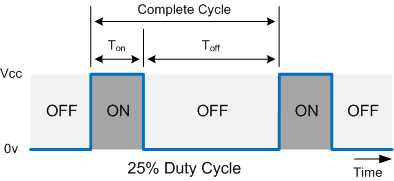Chapter 19. PWM Drivers
Pulse Wide Modulation (PWM) operates like a switch that constantly cycles on and off. It is a hardware feature used to control servomotors, for voltage regulation and so on. The most well-known applications of PWM are:
- Motor speed control
- Light dimming
- Voltage regulation
Now, let's introduce PWM with a simple diagram:

The preceding figure illustrates a complete PWM cycle, introducing some terms that we need to clarify prior to getting deeper into the kernel PWM framework:
Ton: This is the duration during which the signal is high.Toff: This is the duration during which the signal is low.Period: This is the duration of a complete PWM cycle. It represents the sum of theTonandToffof the PWM signal.Duty cycle: This is represented as a percentage of the time signal that remains on during the period of the PWM signal.
The different formulas are detailed as follows:
- PWM period:

- Duty cycle:

Note
You can find details about PWM at https://en.wikipedia.org/wiki/Pulse-width_modulation...

































































